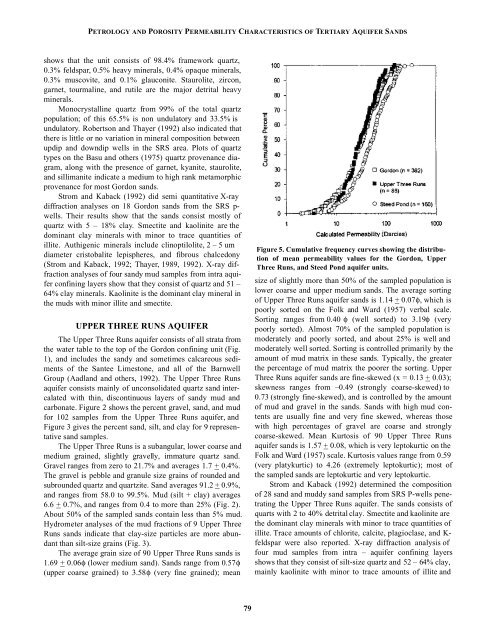Download Guidebook as .pdf (1.8 Mb) - Carolina Geological Society
Download Guidebook as .pdf (1.8 Mb) - Carolina Geological Society
Download Guidebook as .pdf (1.8 Mb) - Carolina Geological Society
You also want an ePaper? Increase the reach of your titles
YUMPU automatically turns print PDFs into web optimized ePapers that Google loves.
PETROLOGY AND POROSITY PERMEABILITY CHARACTERISTICS OF TERTIARY AQUIFER SANDS<br />
shows that the unit consists of 98.4% framework quartz,<br />
0.3% feldspar, 0.5% heavy minerals, 0.4% opaque minerals,<br />
0.3% muscovite, and 0.1% glauconite. Staurolite, zircon,<br />
garnet, tourmaline, and rutile are the major detrital heavy<br />
minerals.<br />
Monocrystalline quartz from 99% of the total quartz<br />
population; of this 65.5% is non undulatory and 33.5% is<br />
undulatory. Robertson and Thayer (1992) also indicated that<br />
there is little or no variation in mineral composition between<br />
updip and downdip wells in the SRS area. Plots of quartz<br />
types on the B<strong>as</strong>u and others (1975) quartz provenance diagram,<br />
along with the presence of garnet, kyanite, staurolite,<br />
and sillimanite indicate a medium to high rank metamorphic<br />
provenance for most Gordon sands.<br />
Strom and Kaback (1992) did semi quantitative X-ray<br />
diffraction analyses on 18 Gordon sands from the SRS p-<br />
wells. Their results show that the sands consist mostly of<br />
quartz with 5 – 18% clay. Smectite and kaolinite are the<br />
dominant clay minerals with minor to trace quantities of<br />
illite. Authigenic minerals include clinoptilolite, 2 – 5 um<br />
diameter cristobalite lepispheres, and fibrous chalcedony<br />
(Strom and Kaback, 1992; Thayer, 1989, 1992). X-ray diffraction<br />
analyses of four sandy mud samples from intra aquifer<br />
confining layers show that they consist of quartz and 51 –<br />
64% clay minerals. Kaolinite is the dominant clay mineral in<br />
the muds with minor illite and smectite.<br />
UPPER THREE RUNS AQUIFER<br />
The Upper Three Runs aquifer consists of all strata from<br />
the water table to the top of the Gordon confining unit (Fig.<br />
1), and includes the sandy and sometimes calcareous sediments<br />
of the Santee Limestone, and all of the Barnwell<br />
Group (Aadland and others, 1992). The Upper Three Runs<br />
aquifer consists mainly of unconsolidated quartz sand intercalated<br />
with thin, discontinuous layers of sandy mud and<br />
carbonate. Figure 2 shows the percent gravel, sand, and mud<br />
for 102 samples from the Upper Three Runs aquifer, and<br />
Figure 3 gives the percent sand, silt, and clay for 9 representative<br />
sand samples.<br />
The Upper Three Runs is a subangular, lower coarse and<br />
medium grained, slightly gravelly, immature quartz sand.<br />
Gravel ranges from zero to 21.7% and averages 1.7 + 0.4%.<br />
The gravel is pebble and granule size grains of rounded and<br />
subrounded quartz and quartzite. Sand averages 91.2 + 0.9%,<br />
and ranges from 58.0 to 99.5%. Mud (silt + clay) averages<br />
6.6 + 0.7%, and ranges from 0.4 to more than 25% (Fig. 2).<br />
About 50% of the sampled sands contain less than 5% mud.<br />
Hydrometer analyses of the mud fractions of 9 Upper Three<br />
Runs sands indicate that clay-size particles are more abundant<br />
than silt-size grains (Fig. 3).<br />
The average grain size of 90 Upper Three Runs sands is<br />
1.69 + 0.06φ (lower medium sand). Sands range from 0.57φ<br />
(upper coarse grained) to 3.58φ (very fine grained); mean<br />
Figure 5. Cumulative frequency curves showing the distribution<br />
of mean permeability values for the Gordon, Upper<br />
Three Runs, and Steed Pond aquifer units.<br />
size of slightly more than 50% of the sampled population is<br />
lower coarse and upper medium sands. The average sorting<br />
of Upper Three Runs aquifer sands is 1.14 + 0.07φ, which is<br />
poorly sorted on the Folk and Ward (1957) verbal scale.<br />
Sorting ranges from 0.40 φ (well sorted) to 3.19φ (very<br />
poorly sorted). Almost 70% of the sampled population is<br />
moderately and poorly sorted, and about 25% is well and<br />
moderately well sorted. Sorting is controlled primarily by the<br />
amount of mud matrix in these sands. Typically, the greater<br />
the percentage of mud matrix the poorer the sorting. Upper<br />
Three Runs aquifer sands are fine-skewed (x = 0.13 + 0.03);<br />
skewness ranges from –0.49 (strongly coarse-skewed) to<br />
0.73 (strongly fine-skewed), and is controlled by the amount<br />
of mud and gravel in the sands. Sands with high mud contents<br />
are usually fine and very fine skewed, where<strong>as</strong> those<br />
with high percentages of gravel are coarse and strongly<br />
coarse-skewed. Mean Kurtosis of 90 Upper Three Runs<br />
aquifer sands is 1.57 + 0.08, which is very leptokurtic on the<br />
Folk and Ward (1957) scale. Kurtosis values range from 0.59<br />
(very platykurtic) to 4.26 (extremely leptokurtic); most of<br />
the sampled sands are leptokurtic and very leptokurtic.<br />
Strom and Kaback (1992) determined the composition<br />
of 28 sand and muddy sand samples from SRS P-wells penetrating<br />
the Upper Three Runs aquifer. The sands consists of<br />
quarts with 2 to 40% detrital clay. Smectite and kaolinite are<br />
the dominant clay minerals with minor to trace quantities of<br />
illite. Trace amounts of chlorite, calcite, plagiocl<strong>as</strong>e, and K-<br />
feldspar were also reported. X-ray diffraction analysis of<br />
four mud samples from intra – aquifer confining layers<br />
shows that they consist of silt-size quartz and 52 – 64% clay,<br />
mainly kaolinite with minor to trace amounts of illite and<br />
79













